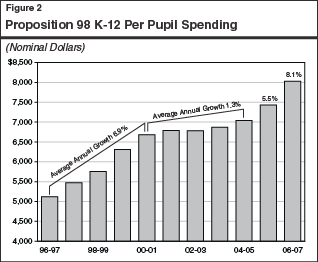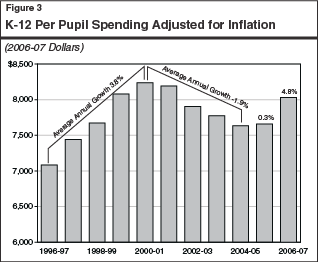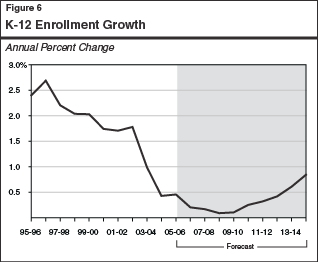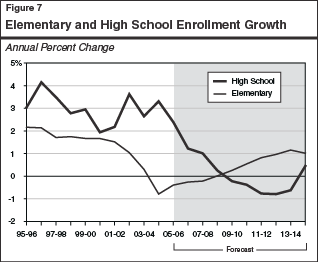Analysis of the 2006-07 Budget BillLegislative Analyst's Office
|
K-12 Education
The budget proposes to provide a $3.7�billion (8.4�percent) increase in K-12 Proposition�98 funding from the 2005-06 level. Compared to the revised current-year level, the proposed 2006-07 funding would provide $1.7�billion more than required by the Proposition�98 minimum guarantee plus $426�million for after school programs as required by Proposition�49. The new funding is used to fully fund attendance growth and provide a cost-of-living adjustment, provide K-12 schools with additional revenue limit general purpose funds, and create several new K-12 categorical programs. Schools would receive $8,030 per pupil, or 8.1�percent more than revised per pupil expenditures in the current year.
Figure�1 displays all significant funding sources for K-12 education for 2004-05 through 2006-07. As the figure shows, Proposition�98 funding constitutes over 70�percent of overall K-12 funding. Proposition�98 funding for K-12 increases $3.7�billion (8.4�percent) from the 2005-06 level. This increase is supported mainly by the General Fund ($3.6 billion). Growth in local property tax revenues for Proposition 98 is only $118 million (1�percent) in 2006-07. This is primarily due to transfers of local property taxes to local governments, as discussed below. Other funding for K-12 increases by a combined $379�million (2.2�percent).
|
|
|||||
|
Figure 1 K-12 Education Budget Summary |
|||||
|
(Dollars in Millions) |
|||||
|
|
Actual 2004‑05 |
Revised 2005‑06 |
Proposed 2006‑07 |
Changes From 2005‑06 |
|
|
|
Amount |
Percent |
|||
|
K-12 Proposition 98 |
|
|
|
|
|
|
State General Fund |
$30,863 |
$32,792 |
$36,403 |
$3,611 |
11.0% |
|
Local property tax revenue |
11,265 |
11,845 |
11,963 |
118 |
1.0 |
|
Subtotals, K-12 Proposition 98 |
($42,128) |
($44,637) |
($48,366) |
($3,729) |
(8.4%) |
|
Other Funds |
|
|
|
|
|
|
General Fund |
|
|
|
|
|
|
Teacher retirement |
$1,050 |
$999 |
$997 |
-$2 |
-0.2% |
|
Bond payments |
1,608 |
1,731 |
1,991 |
260 |
15.0 |
|
Other programs |
779 |
550 |
623 |
73 |
13.3 |
|
State lottery funds |
810 |
1,022 |
1,022 |
— |
— |
|
Other state programs |
110 |
125 |
146 |
21 |
16.8 |
|
Federal funds |
7,483 |
7,456 |
7,469 |
13 |
0.2 |
|
Local funds |
5,587 |
5,602 |
5,616 |
14 |
0.2 |
|
Subtotals, other funds |
($17,427) |
($17,485) |
($17,864) |
($379) |
(2.2%) |
|
Totals |
$59,555 |
$62,122 |
$66,230 |
$4,108 |
6.6% |
|
K-12 Proposition 98 |
|
|
|
|
|
|
Average daily attendance (ADA) |
5,982,372 |
6,010,454 |
6,023,040 |
12,586 |
0.2% |
|
Amount per ADA |
$7,042 |
$7,427 |
$8,030 |
$604 |
8.1 |
|
|
|||||
|
Totals may not add due to rounding. |
|||||
|
|
|||||
Local Government Deals Require Higher General Fund Support for Proposition�98. The K-12 share of Proposition�98 supported by the General Fund has increased from 67�percent in 2003-04 to 75�percent, or $3.6 billion, in the proposed budget. The main cause of the increased General Fund share is related to state-level decisions affecting the allocation of local property tax revenues. Property tax revenues were redirected from schools to local governments, requiring additional General Fund revenues to serve as a �backfill.� See the �Proposition 98 Update� section of this chapter for a more detailed discussion of these developments.
Proposed Increases in Non-Proposition�98 Spending. The budget proposes to increase non-Proposition�98 funding for K-12 by $379�million in 2006-07. The key changes include:
School Bond Debt Service-Increase of $260�Million. The budget�s increase in debt service on school bonds reflects recent investments the state has made in school construction and renovation through Proposition�1A (1998), Proposition�47 (2002), and Proposition�55 (2004).
State Lottery-Revenues Increase ($212 Million). The 2005-06 Budget Act assumed K-12 education would receive $810 million in revenue from the California Lottery-similar to level of revenue projected received in the prior year. The administration reports that updated information from the Lottery Commission indicates 2005-06 K-12 revenues will exceed $1 billion due to higher-than-anticipated sales, an increase of $212 million over projected 2004-05 amounts. The Governor�s budget estimates this higher level of lottery revenue will continue in 2006-07.
Federal Funding Increases of $13�Million. The Governor�s budget, finalized prior to passage of the federal 2006 budget (October 2005 to September 2006), assumed an increase of $13 million in federal funding in 2006-07. We now have early estimates of the year-to-year change in federal funding which indicate that federal funding for California education will decrease in 2006-07. Thus, the Governor has likely overbudgeted federal funds. The Department of Finance (DOF) traditionally reflects these revisions in the May Revision.
The Governor�s budget provides an additional $604 per pupil in Proposition 98 funding, an 8.1 percent increase from the current year. Figure 2 shows per-pupil spending in dollars over the last decade. (The numbers are in �nominal� dollars-that is, not adjusted for the effects of inflation.) The figure shows three distinct trends-a fast growth period in the late 1990s, a slow growth period between 2000-01 and 2004-05, and significant increases in the current and budget years. Spending per pupil increased in each year of this period.

Figure�3 adjusts per-pupil spending for inflation. While K-12 spending still shows rapid growth in the late 1990s, between 2000-01 and 2004-05 it did not keep pace with rising costs, declining, on average, 1.9�percent per year. This trend began to change in 2005-06. Building on the slight increase provided in the current year, the Governor�s proposal would grow per-pupil spending an additional 4.8�percent. Looking at changes over the last decade, spending (in inflation-adjusted terms) has increased by approximately $946 per pupil (17�percent).

Figure 4 displays the major K-12 funding changes from the 2005-06 revised budget. In 2006-07, the Governor�s budget proposes $3.7�billion in new Proposition�98 K-12 expenditures for the following purposes.
|
|
|
|
Figure 4 Major K-12 Proposition 98 Changes |
|
|
(In Millions) |
|
|
2005‑06 Revised K-12 Spending Level |
$44,637 |
|
Revenue Limit |
|
|
Cost-of-living adjustments (COLAs) |
$1,689.3 |
|
Growth |
54.3 |
|
Declining enrollment adjustment |
13.2 |
|
PERS/UIa |
-136.0 |
|
Deficit factor reduction (including basic aid) |
206.2 |
|
Equalization |
200.0 |
|
Subtotal |
($2,027.0) |
|
Categorical Programs |
|
|
COLAs |
$594.1 |
|
Growth |
88.6 |
|
Proposition 49 after school programs |
426.2 |
|
Mandates |
133.6 |
|
Recruitment and Retention—low performing schoolsb |
100.0 |
|
Arts and music block grant |
100.0 |
|
Physical education |
85.0 |
|
Expand beginning teacher program |
65.0 |
|
Digital classroom grants |
25.0 |
|
Restore categoricals funded with one-time funds |
23.2 |
|
Other |
60.5 |
|
Subtotal |
($1,700.9) |
|
Total Changes |
$3,727.9 |
|
2006‑07 Proposed |
$48,366.4 |
|
|
|
|
a Public Employees' Retirement System/Unemployment Insurance. |
|
|
b The 2005-06 Budget provided $49.5 million in one-time funds for the recruitment and retention of teachers in low performing schools. In 2006-07 the Governor proposes to increase the funding level to $100 million and to fund the program with ongoing funds. |
|
|
|
|
Revenue Limit Growth and Cost-of-Living Adjustments (COLAs)-$1.7�Billion. The Governor fully funds 0.2�percent enrollment growth in revenue limits ($54�million), and a 5.2�percent COLA ($1.7�billion).
Deficit Factor Reduction-$206�Million. In 2003-04, the state did not provide a COLA (1.8�percent), creating an obligation to restore the reduction at some point in the future. That obligation is referred to as the �deficit factor.� Over the last two years the state has been restoring those funds. The budget provides $205�million to restore roughly two-thirds of the outstanding deficit factor, reducing it from around 0.9�percent to around 0.3�percent for school districts and 0.1�percent for county offices of education. It also provides about $1�million to eliminate the corresponding categorical program reduction for basic aid districts.
Revenue Limit Equalization-$200�Million. The Governor proposes $200�million to reduce historical inequities in general purpose spending.
Categorical Growth and COLAs-$683�Million. The Governor fully funds growth and COLAs for categorical programs.
Proposition�49-$426�Million. The proposed budget includes $426�million to fully fund Proposition�49 after school programs. (In addition to these Proposition�98 funds, the budget provides $2�million to the California Department of Education for administration and evaluation.)
New and Expanded Programs-$375�Million. The Governor proposes $375�million to create or expand categorical programs, including: grants for low performing schools ($100�million), school art grants ($100�million), physical education ($85�million), teacher training ($65�million), and education technology ($25�million).
Mandates-$133�Million. The budget proposal includes $133�million to reimburse schools for a significant portion of the ongoing costs of mandates. (In addition, the budget provides $152�million in one-time funds to partially pay for mandate claims from prior years.)
Figure�5 shows Proposition�98 spending for major K-12 programs. The budget provides $34�billion for revenue limits, $3.4�billion for special education, and almost $1.8�billion for K-3 class size reduction (CSR). The figure also shows that the budget proposal includes a significant increase in funding for after school programs (resulting from the �trigger� of Proposition�49) and for mandates.
|
|
||||
|
Figure 5 Major K-12 Education Programs |
||||
|
(Dollars in Millions) |
||||
|
|
Revised 2005‑06a |
Proposed 2006‑07a |
Change |
|
|
|
Amount |
Percent |
||
|
Revenue Limits |
|
|
|
|
|
General Fund |
$20,539.7 |
$22,469.1 |
$1,929.3 |
9.4% |
|
Local property tax |
11,493.5 |
11,593.9 |
100.4 |
0.9 |
|
Subtotals |
($32,033.3) |
($34,063.0) |
($2,029.7) |
(6.3%) |
|
Categorical Programs |
|
|
|
|
|
Special educationb |
$3,241.9 |
$3,415.6 |
$173.7 |
5.4% |
|
K-3 class size reduction |
1,676.3 |
1,751.1 |
74.9 |
4.5 |
|
Child development and care |
1,220.9 |
1,261.5 |
40.6 |
3.3 |
|
Targeted Instructional Improvement Block Grant |
976.3 |
1,029.0 |
52.7 |
5.4 |
|
Adult education |
648.0 |
698.6 |
50.6 |
7.8 |
|
Economic Impact Aid |
586.9 |
648.1 |
61.3 |
10.4 |
|
Home-to-school transportation |
568.8 |
599.5 |
30.7 |
5.4 |
|
After School Education and Safety Program |
121.6 |
547.8 |
426.2 |
350.7 |
|
Regional Occupation Centers and Programs |
420.7 |
454.4 |
33.7 |
8.0 |
|
School and Library Improvement Block Grant |
422.4 |
445.2 |
22.8 |
5.4 |
|
Instructional Materials Block Grant |
361.0 |
401.5 |
40.6 |
11.2 |
|
Mandated supplemental instruction (summer school) |
354.8 |
374.0 |
19.2 |
5.4 |
|
Deferred Maintenance |
267.9 |
268.5 |
0.6 |
0.2 |
|
Professional Development Block Grant |
249.3 |
262.8 |
13.5 |
5.4 |
|
Public School Accountability Act |
249.2 |
249.2 |
— |
— |
|
Mandates |
—c |
133.6 |
133.5 |
— |
|
Other |
1,258.3 |
1,763.0 |
504.8 |
40.1 |
|
Deferrals and other adjustments |
-20.1 |
— |
20.1 |
— |
|
Subtotals |
($12,603.9) |
($14,303.4) |
($1,699.5) |
(13.5%) |
|
Totals |
$44,637.2 |
$48,366.4 |
$3,729.2 |
8.4% |
|
|
||||
|
a Amounts adjusted for deferrals. We count funds toward the fiscal year in which school districts programmatically commit the resources. The deferrals mean, however, that the districts technically do not receive the funds until the beginning of the next fiscal year. |
||||
|
b Special education includes both General Fund and local property tax revenues. |
||||
|
c Less than $100,000. |
||||
|
|
||||
Enrollment growth significantly shapes the Legislature�s annual K-12 budget and policy decisions. When enrollment grows slowly, for example, fewer resources are needed to meet statutory funding obligations for revenue limits and K-12 education categorical programs. This leaves more General Fund resources available for other budget priorities both within K-12 education and outside it. Conversely, when enrollment grows rapidly (as it did in the 1990s), the state must dedicate a larger share of the budget to education. In light of the important implications of enrollment growth, we describe below two major trends in the K-12 student population.
The enrollment numbers used in this section are from DOF�s Demographic Research Unit and reflect aggregate, statewide enrollment. While the enrollment trends described here will likely differ from those in any given school district, they reflect the overall patterns the state is likely to see in the near future.
K-12 Enrollment Growth to Slow Significantly. K-12 enrollment is projected to increase by about 0.2�percent in 2006-07, bringing total enrollment to 6.3�million students. Figure�6 shows how enrollment growth has steadily slowed since the mid-1990s. The figure also indicates that K-12 enrollment growth will continue to slow until 2009-10, when it will turn upward.

Divergent Trends in Elementary and High School Enrollment. Figure�7 shows that the steady decline in K-12 enrollment growth masks two distinct trends in elementary (grades K-8) and high school (grades 9 through 12) enrollment. Elementary school enrollment growth has slowed since 1996-97, with actual declines in recent years. In contrast, high school enrollment growth had been growing rapidly, with a 3.3�percent increase in 2004-05. Beginning in 2005-06, however, high school enrollment growth also began to slow. This trend is expected to continue, with actual declines projected beginning in 2009-10. Between 2008-09 and 2014-15, high school enrollment will fall by almost 47,000 students.

Budget and Policy Implications. These enrollment trends have significant budgetary and policy implications for issues such as CSR, teacher demand, and facilities investment. A few of the major implications include:
An increase of 1 percent in K-12 enrollment requires an increase of approximately $480�million to maintain annual K-12 expenditures per pupil.
As enrollment growth slows, a smaller share of the state's new revenues will be consumed by costs associated with funding additional pupils. The Legislature will then have the option of devoting these revenues to increasing per-pupil spending or to other budget priorities.
In the near term, programs aimed at elementary grades (such as K-3 CSR) will face reduced cost pressures related to enrollment. Programs aimed at high school grades will face increased cost pressures. This could present cost challenges for many unified school districts because per-pupil costs of educating high school students tend to be higher than for elementary school students.
Because of declining enrollment provisions in state law, more school districts-especially elementary school districts-will benefit from the one-year hold harmless provision in current law, increasing state costs per pupil. The declining enrollment adjustment cost the state $242�million in 2004-05, compared to only $74�million in 2001-02.
Despite the general downward trend in enrollment growth, significant variation is expected to occur across counties. For example, between 2004-05 and 2014-15, Los Angeles' enrollment is expected to decline by around 162,000 students (a 10�percent decline), whereas Riverside�s enrollment is expected to increase by over 132,000 students (a 35�percent increase).
Slowing enrollment growth will likely affect the uses of new capital outlay bond funding. Fewer students indicates a decreasing statewide need for new construction dollars, and suggests that an increasing proportion of bond funding should instead be directed towards upgrades and modernization of existing school facilities.
The percent of Hispanic students will continue to increase. In 1995-96, 39�percent of students were Hispanic. By 2013-14, 54�percent will be Hispanic. Since many of these students will be English learners, the state will need to increase its focus on the language development skills of this group.